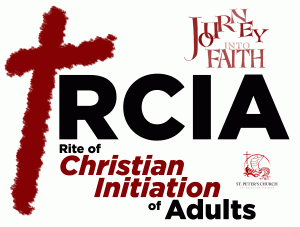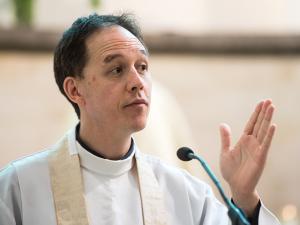
Celebrations of Grace: The Sacraments of the Catholic Church, Part 12
A lengthy babysitting assignment has this grandparent’s mind on things far away from my next intended topic, RCIA, the Rite of Christian Initiation of Adults. (So writing is going slower than usual.) And yet there’s a connection. Babysitting and parenting are all about facing the future with welcoming and, to be honest, trembling arms. So is Baptism.
Baptism changes the Church just as a baby born changes a family. In the RCIA that element of change is more obvious because an adult with an independent history is coming in. Often we say that in Baptism we die to the old self and rise with a new life in Christ. But that dying doesn’t exactly leave the old self behind. God’s grace was at work there, outside the Church, all along. In Baptism we welcome those new graces. And who knows what the Church might become then?
Mission
The resurrection Jesus gave the Church a unique and bold mission:
Go and make disciples of all nations, baptizing them in the name of the Father, and of the Son, and of the holy Spirit. (Matthew 28: 19)
It took a long time for the Church to learn what that meant, although Paul knew it very early. In his letter, especially Galatians, he insisted God’s kingdom could not be limited to one tribe or one culture. Since then the Church has gone through periods of inculturation in new cultures and a long period in which the Church practically identified herself with Roman culture.
My first acquaintance with mission work consisted of giving money so our missionaries could save “Pagan babies.” Some Christian groups still imagine they are bringing salvation to people who are “lost,” far from God.
Today Catholic missionary societies see their work differently. Here is a statement from the Jesuit mission site:
We are expected to do anything or go anywhere to help people experience Jesus Christ in their daily lives.
In other words, in some way Jesus is already there. The RCIA process also tries to help people find Jesus in their lives. That presence is as much a gift to the Church as anything the Church has to give.
RCIA
I have not worked with the RCIA process in any of the parishes to which I have belonged. I’ve only seen it from the outside. The point here is that there is an outside. You can see it.
Formerly, when an adult wanted to become Catholic, he or she would go to a priest, receive some lessons in private, and then be baptized, also essentially in private. Unless you knew the person before, you would never know that the Church had undergone a change through the addition of a new member.
Today welcoming an adult convert involves the whole local church, including the bishop. It’s an important moment for the Church, not just for one individual. Consequently, the RCIA process includes several moments of public exposure for the Baptism candidate.
After a period of inquiry, a seeker asks to enter the Order of Catechumens in a public Rite of Acceptance. The parish assembly affirms this desire and the inquirer becomes a Catechumen. During this Catechumenate the person works with a parish team to understand what it means to be a Catholic and to understand better his or her own desire. This person now has a special relationship to the Church, even before Baptism.
If the inquirer wants to move forward, there follows a Rite of Election, typically during a Mass at the cathedral church on the first Sunday of Lent. Catechumens from around the diocese will state their desire for Baptism to the bishop. Their names will be recorded in a Book of the Elect.
As Lent proceeds the elect will pray and study with the help of a spiritual director, Their parish communities will pray for them, especially at three rites called Scrutinies during the three middle Sundays of Lent. The following description comes from Online Ministries:
Invitation to Silent Prayer
One of the most powerful moments of the Scrutinies is how they begin. After the homily, the Elect are invited to come forward with their sponsors and to kneel down. Then, the whole assembly is invited to pray for them in silence. It is a very solemn moment. This community has cared for these elect for some months now on their journey. We have sent them to reflect more and more deeply on the Word of God, and expressed to them our longing for the day on which they would join us at the table of the Lord. Now we pray for them in this sacred silence, deeply asking God to protect them and heal them in the weeks ahead.
Intercessions for the Elect
We then pray out loud together for the Elect.
Prayer of Exorcism
Then, we pray that they might be freed from the power of the Evil One and protected on their journey.
The Laying On of Hands
In a silent ritual deliberately reminiscent of the rite used for ordination in the Sacrament of Holy Orders, the priest or deacon lays his hands for a brief moment on the head of each of the Elect. It is a solemn act of calling down the Spirit of Jesus to be with them and protect them.
Dismissal of the Elect
The Elect are then sent forth to reflect upon the Word and this powerful gesture of love on the part of this community, that cares for them so deeply, with the love of Christ.
Finally, at the Easter Vigil the community will celebrate the sacraments of Baptism, Confirmation, and Eucharist with the new Church members.
Belonging and identity
Baptism is the way an individual takes on the identity of God’s people, but with each new addition that identity changes. What’s more Jesus has commanded us to baptize “the nations.” The desire to belong lies deep in each person’s psyche. Baptism takes that desire and purifies it of what typically follows – the need one feels to have an opposite to which one does not belong.
The Church has an ancient teaching on the necessity of Baptism for salvation. It’s the way one joins the community of the saved. The Church also says God in his mercy can save persons who are not baptized. And Jesus has set the Church on the dangerous mission of facing her future in the form of each person who has not heard, or not heard sufficiently, the story of God’s people and God’s anointed one, Jesus.
Jesus’ command to baptize the nations requires Christian families and communities to create ways of welcoming and walking with everyone, including strangers, people of diverse backgrounds, and those whose mistaken sense of their identity leads them to seek belonging through inappropriate or harmful behavior. Baptism is a frequently recurring challenge.
Baptism isn’t just for one individual at a time; it’s for all of us present and for the whole family of God. We are baptized individually, each on a particular day in our lives. But the reason Jesus commanded us to baptize “the nations” isn’t to save more and more individuals. It’s because that is the strange identity Jesus gave to the community of the saved,
Unless the Church is reborn of water and the Holy Spirit over and over, it cannot , be saved. Unless we welcome the stranger, and do it over and over again, we cannot be the community of the saved.
Image credit: St. Peter’s Church, Toronto, via Google Images












